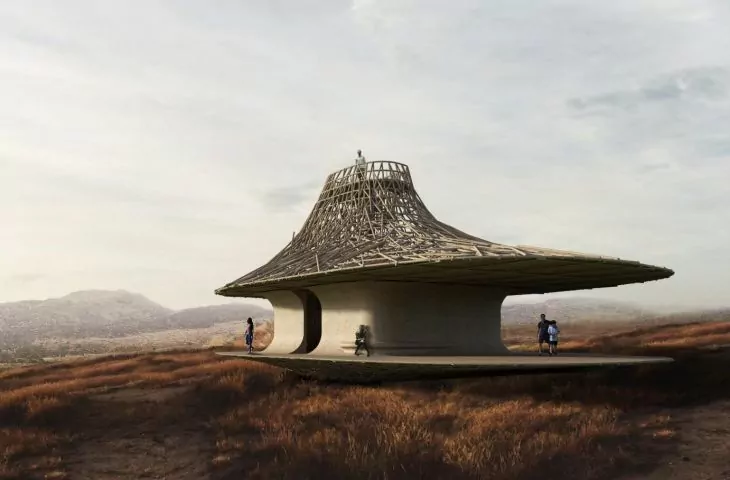A building made of natural materials sprouting in the middle of the Serengeti National Park is the project for which {tag:studenci} from Wroclaw University of Technology was awarded first prize in the "Terrea Pura" competition. The frugal structure with an observation tower and terrace, made of earth and bamboo stalks, impressed the international jury.
The challenge of the Terra Purra competition, organized by the UNI platform, was to design an object that is a lookout point, or a pavilion with a viewing tower located on the site of the Ngorongoro Crater in Tanzania - not far from the ecotourism center already operating there. The location suggested by the organizers is part of the Serengeti National Park, which is one of the largest and most famous protected areas in the world. The park is located in the Maya and Simiyu regions and is famous for the annual migration of white-bellied wildebeest and zebras. The area is also home to Nile crocodiles and the largest concentration of lions. Spanning 14750 square kilometers, it is one of the most diverse national parks in the world and includes grasslands, riparian forests and woodlands.
The site combines several functions, with one of the most important being a viewing point
© Szymon Król
object hidden in the terrain
The area designated for the competition project offers a picturesque view of Lake Magadi, which is located at the foot of the crater. Participants were allowed to design a facility covering an area of about 1,000 square meters. They were to include in the facility: a reception area, an observation deck, an observation tower, a small restaurant, a convenience store, technical facilities, and there was to be a parking lot.
An important aspect was that the proposals submitted should interfere as little as possible with the surroundings and be built with local materials, taking into account construction techniques traditional to the region. The proposed facilities were to blend in with the surroundings, allow contact with nature and not encroach on the area where animals live.
the building was to interfere as little as possible with the surroundings, and its construction was to be made of local materials
© Szymon Król
first prize for a PWr student
The submitted works were judged by an international three-member jury consisting of: Faith Okuma (Surroundings Studio), Michel Lefevre (Michel Lefevre), Richard Bennett (rbmp). Among the submissions was the work of Szymon Król from Wroclaw University of Technology, which received first prize.
Unusual, innovative and beautiful development of the concept and execution of the project. It was an honor to judge the work at such a level," commented, juror Faith Okuma.
The building, made of local soil and covered with a bamboo roof, was designed under the direction of Dr. Andrzej Sobolewski of the Department of Public Utility Architecture, Fundamentals of Design and Environmental Design at Wroclaw University of Technology as part of a college course.
The walls were made of earth and the roof of bamboo shoots
© Szymon Król
I located the project in the western part of the Ngorongoro Crater, part of the Serengeti National Park. It is the tourist center of this region of Tanazania, which is famous for the annual migration of many wild species. This is an unusual area, which had to be approached with great sensitivity and respect for the existing greenery and landscape. I decided to place the designed structure above the slope of the crater, which enhances the amazing views from this place," explains Szymon Król.
Earth, bamboo and wood
The young architect tried to design the building with respect for the surrounding nature and using local architectural influences. So he used local materials such as soil and wood, including bamboo wood, to create the building. Earth, through the use of Superdobe technology served as the main material for the building's structural walls. This technology involves the use of cylindrical bags into which soil is poured and then covered with a mixture of cement, which ensures the stability and rigidity of the structure.
An observation deck wraps around the entire building
© Szymon Król
The use of the aforementioned construction technology was very important to me, due to the fact that in the event of a hypothetical construction, we would be able to hire the local community, which interacts with this technology on a daily basis, to help, the author adds.
natural camouflage
All of the facility's functions, such as the reception area, the check-in area, the stairs leading to the observation tower, the space for the equipment necessary for tourists, along with changing rooms, and the area where we can have a drink and a meal, were placed by the author in the central part of the observation terrace. Such a solution makes the terrace wrap around the building, and for tourists walking on it, the object does not restrict the view from either side. The openwork canopy was covered with irregularly interwoven bamboo stalks, in this way rainwater is collected, which flows down the transparent membrane through specially designed slopes. Then, after a filtration process, it enters the restaurant room, where it serves as drinking water for visitors. The membrane illuminates the facility, allowing natural daylight into the interiors.
The transparent membrane illuminates the interiors
© Szymon Król
The biomorphic forms and the aforementioned irregularity of the bamboo stalks used in the canopy mean that to a tourist looking from afar, the facility can resemble local vegetation and mountain peaks blurring in the distance. This helps to camouflage the building. All these design measures are meant to emphasize that man is only a guest here, and so he, as well as his interference in such an unusual landscape, should remain almost unnoticeable among the animal and plant kingdom," concludes Szymon Król.










































